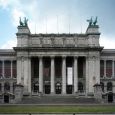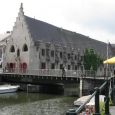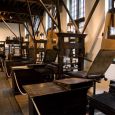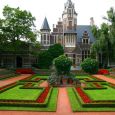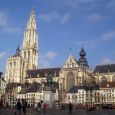Antwerp
Advertisement
By Air
Antwerp has its own international airport that has good connections with airports across the UK via London City Airport as well as links to the Channel Isles, Innsbruck, Milan and Rotterdam. The city is also within easy reach of Brussels’ Zaventem Airport, which has frequent bus and train services linking it with Antwerp.
By Rail
Antwerp’s two main train stations, Centraal Station and Berchem Station, are both on the Thalys rapid train system that links Paris, Brussels and Amsterdam via high-speed services. Trains run at least hourly in each direction, making train travel between these European capitals very fast and convenient. From Brussels, you can connect to Cologne and beyond.
By Bus
Antwerp’s long-distance bus station is located on Franklin Rooseveltplaats, not far from Centraal Station, and has services to all main western European cities. The bus station also has regular local services to smaller towns and villages in the Antwerp region.
By Ferry
There are many ferry ports along the coast between northern France and southern Netherlands, of which Ostend is the most convenient for visitors travelling to Antwerp. Ostend Port has regular ferry services from Dover and Ramsgate in southeast England, with the passage taking around 4 hours. Ostend has regular bus and rail links to Antwerp.
Advertisement
Cathedral of Our Lady
The Onze Lieve Vrouwkathedraal, Belgium's largest Gothic church and the largest of its kind in the Netherlands, stands a short distance southeast of the Grote Markt. Work was started on the cathedral in 1352, continuing until 1521. Jacob van Thienen, Pieter Appelmans, Jan Tac, Everaert Spoorwater, Hermann and Dominic de Waghemakere and Rombout Keldermans were among the architects and masterbuilders who contributed to its construction.
The church has suffered serious damage on a number of occasions over the years, depriving it of many of its most precious works of art. First came a fire in 1533, then despoliation at the hands of dissident iconoclasts in 1566,Calvinists in 1581 and French Republican troops in 1794 and 1800. Sadly only a few of the lost treasures have since been recovered.
Restoration of the exterior was begun in the 19th C. and all the carved stonework on the outside of the building is therefore recent. Work on the interior began in 1965, starting with the nave where repairs were completed in 1983. Currently the choir and transepts are being restored and will not be fully accessible for quite some time. The finest of the remaining works of art are meanwhile displayed in the nave and aisles as well as in the cathedral treasury.
Antwerp Zoo
Located right in the midst of the city, immediately behind Centraal Station, the 10ha/25 acre Antwerp Zoo was founded in 1843. It is widely regarded as one of the finest zoos in Europe on account of its variety of species, its success in breeding, the care bestowed on the animals, kept in the most natural environment possible, and, last but by no means least, its architecture.
Plantin-Moretus Museum
In 1576, Christophe Plantin the printer who hailed originally from France, moved into a house he christened "De gulden Passer" - the Golden Compasses - close by the Vrijdagmarkt (south of the Grote Markt). Thereafter Plantin and his heirs the Moretus family extended the house, ultimately bequeathing to posterity a supreme example of Flemish Renaissance architecture (though the facade facing the Vrijdagmarkt was an 18th C. addition). Today the building is a museum. It incorporates the Old Flemish patrician house, the quiet, vine-covered inner courtyard, and the commercial premises, the latter including an early print-works complete with office and typesetters' room, all in an unparalleled state of preservation. The original furnishings,the wide-ranging exhibits, some of which are unique, but above all, the still tangible atmosphere arising from the proximity of home and workplace, enthrall every visitor and make the Plantin-Moretus Museum one of Antwerp's premier attractions.
Museum of Fine Arts
The Koninklijk Museum voor Schone Kunsten (Royal Museum of Fine Arts) celebrated its centenary in 1990, having opened its doors 11 years after work began on its Neo-Classical building in 1879. The nucleus of the museum's collection belonged originally to the Lucas Guild of Painters and Sculptors, founded in 1442. Following the winding up of the guild in 1773 the works of art accumulated over the years passed into the possession of the Academy of Fine Arts and were housed in the Academy's premises in the old Minorite monastery. In the mid 19th C. however the collection was swollen by a substantial number of new acquisitions, particularly gifts, mainly of 15th and 16th C. paintings, from Florent van Ertborn, a former burgomaster of Antwerp. The Academy found itself with insufficient space to accommodate the enlarged collection and the decision was taken to build a new museum.
The collection is housed on two floors. The ground floor is largely devoted to modern i.e. 19th and 20th C. paintings and sculpture, some 1,500 items in all, providing among other things an excellent overview of the development of the plastic arts in Belgium since 1830. The exhibition of Old Masters on the first floor comprises more than 1000 works, mostly from the Flemish and Dutch schools.
Butcher's Hall
The elegant rooms of the late Gothic Vleeshuis (Butchers' Hall) in the Vleeshouwerstraat include the former council chamber of the butchers' guild. The impressive brick building, built in 1501-04, was deliberately sited close to the Scheldt, allowing the blood of slaughtered animals to run off into the river.
The Vleeshuis is now a museum of applied art and archaeology with collections of pre-historic, Egyptian, Roman and Merovingian artifacts; weapons and armor; ceramics; furniture; sculpture and woodwork; and coins. Among its most prized possessions are a depiction of the conversion of Saul in 16th C. Antwerp tiles, the Averbode Retable by Pieter Coecke van Aelst.
Information not available
January - February -> 3(°C) - Winter
July - August -> 18(°C) - Summer
Advertisement

